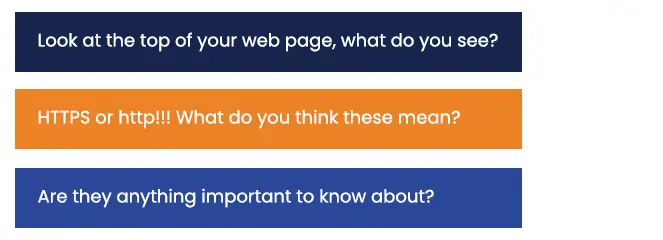

If not, have you ever seen HTTP or HTTPS:// in a browser's address bar while browsing a website? If neither of these is present, the problem is very certainly HTTP://. Let's have a look at the differences...
In a word, both of these protocols are used to convey information between a Web Server and a Web Browser about a certain website. But, what's the difference between the two? The addition of as to HTTPS makes it secure! It's amazing how much of a difference it makes. The only important difference between HTTP and HTTPS is that HTTPS is significantly more secure.
Well, let us read more about HTTP and HTTPS differences such that we can use them for better SEO or similar technical understanding.
HTTP stands for Hypertext Send Protocol, and it is a protocol (or a set of rules for presenting data) that is used to transfer data over the internet. The HTTP protocol is used to send most data across the Internet, including website content and API calls.
HTTP messages are divided into two categories: requests and responses. As a person interacts with online properties, their browser generates HTTP requests. When a user clicks on a hyperlink, for example, the browser sends a sequence of "HTTP GET" requests for the content on that website. These HTTP requests are sent to an origin server or a proxy caching server, which will respond with an HTTP response. Replies to HTTP requests are known as HTTP responses.
HTTP requests and responses are delivered unencrypted across the Internet. The issue is that these plaintexts can be read by anyone watching the connection. This is particularly problematic when consumers input sensitive information through a website or online application. This might be anything from a password to a credit card number to any other information entered into a form. Essentially, a malicious actor can read the content of a request or response and determine exactly what information is being requested, provided, or received, and even modify the conversation.
HTTPS is the solution to the aforesaid security issue.
In order to understand HTTPS vs HTTP, it is important that we know both of them in detail and here we have mentioned the basics of HTTPS in detail. Let us have a look at the same before we jump to talk about what is HTTPS vs HTTP.
Hypertext Transfer Protocol Secure (HTTPS) is a secure version of the HTTP protocol (also referred to as HTTP over TLS or HTTP over SSL). HTTPS encrypts HTTP requests and responses with TLS (or SSL), so an attacker would see a series of seemingly random characters instead of the plaintext.
TLS employs public key encryption, which consists of two keys: a public key and a private key. The server's SSL certificate is used to exchange the public key with client devices. A Certificate Authority (CA) signs the certificates cryptographically, and each browser has a list of CAs it implicitly trusts. Because it has been confirmed to be "trusted" and belongs to that domain, every certificate signed by a CA in the trusted list is given a green padlock lock in the browser's address bar. Let's Encrypt, for example, has made the process of issuing SSL/TLS certificates completely free.
Each computer requires a validated identity when a client connects to a server. As a result, the public and private keys are used by the two devices to agree on new keys, known as session keys, to encrypt future connections. These session keys are then used to encrypt all HTTP requests and responses, ensuring that anyone intercepting communications only sees a random string of characters rather than the plaintext.
HTTPS is used to authenticate the two communicating parties in addition to encrypting communication. Authentication is the process of confirming that a person or computer is who they say they are. There is no identity verification in HTTP; instead, it is based on a trust basis. Authentication, on the other hand, is critical in today's Internet.
A private key confirms server identity in the same way as an ID card proves a person's identity. Possession of the private key that matches the public key in a website's SSL certificate proves that the server is the authentic host of the website when a client opens a channel with an origin server (e.g. when a user navigates to a website). Man-in-the-middle attacks, DNS hijacking, and domain spoofing are all feasible when there is no authentication, and thus avoids or helps block them.
It is a highly advanced and secure HTTP version. For data communication, it uses port 443. By encrypting all communication using SSL, it provides for secure transactions. It's a hybrid of the SSL/TLS and HTTP protocols. It allows a network server to be identified in an encrypted and safe manner.
HTTP also enables the server and browser to establish a secure encrypted connection. It provides data security in both directions. This assists you in preventing the theft of potentially sensitive information.
SSL transactions are negotiated using a key-based encryption method in the HTTPS protocol. The strength of this key is usually 40 or 128 bits.
Let us talk about the HTTPS vs HTTP difference:
HTTP vs. HTTPS: What's the Difference?
Are there any limitations which we should take into consideration?

Let us talk about the HTTP and HTTPS difference based on factors such as HTTPS vs HTTP security, HTTPS vs HTTP security, protocol and much more.
Now you must be in a good state to answer whether to go with https or http.
Despite the fact that migrating from HTTP to HTTPS is a one-way street, many people become sidetracked, owing to the overwhelming number of options presented to them.
In a nutshell, the above-mentioned procedure consists of four steps:
Many hosting firms now include SSL Certificates as part of their services, and they handle the majority of the work themselves (the first three of four steps mentioned above). All you have to do now is direct your visitors to the updated locations. But watch out! You may have to pay a few extra bucks as a result of this.
Whatever the case may be, the Internet currently has over 4 billion users, including content consumers, shoppers, and others. The combination of user demand (site visitors are more concerned about data security than ever before), laws (e.g. PCI DSS), and browser encouragement (e.g. plans to flag HTTP sites as non-secure) indicates that the full transition from HTTP to HTTPS will be completed soon.
Leave a Reply